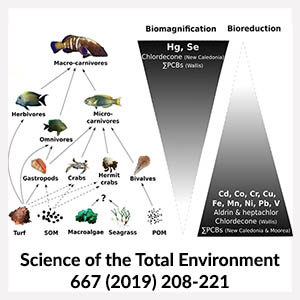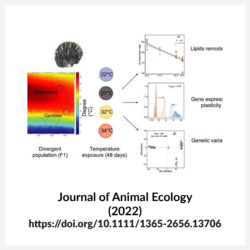
Publication Scientifique
Jérémy Le Luyer, Cristian J. Monaco, Léo Milhade, Céline Reisser, Claude Soyez, Hirohiti Raapoto, Corinne Belliard, Gilles Le Moullac, Chin‐Long Ky, Fabrice Pernet, Gene expression plasticity, genetic variation and fatty acid remodelling in divergent populations of a tropical bivalve species, Journal of Animal Ecology, 10.1111/1365-2656.13706, (2022).
ABSTRACT
- Ocean warming challenges marine organisms' resilience, especially for species experiencing temperatures close to their upper thermal limits. A potential increase in thermal tolerance might significantly reduce the risk of population decline, which is intrinsically linked to variability in local habitat temperatures.
- Our goal was to assess the plastic and genetic potential of response to elevated temperatures in a tropical bivalve model, Pinctada margaritifera.... lire la suite
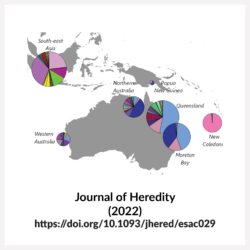
Publication Scientifique
Claire Garrigue, Claire Daisy Bonneville, Christophe Cleguer, Marc Oremus, Extremely Low mtDNA Diversity and High Genetic Differentiation Reveal the Precarious Genetic Status of Dugongs in New Caledonia, South Pacific, Journal of Heredity, 2022;, esac029, https://doi.org/10.1093/jhered/esac029
ABSTRACT
New Caledonia is home to one of the largest remaining populations of dugongs (Dugong dugon) and is located at the southeastern limit of the species range. Local knowledge suggests that current levels of removal due to anthropogenic pressures are unsustainable, whereas trends suggest an ongoing decline in the population. Considering this unfavorable conservation context, this study aimed to assess the New Caledonian dugong population’s resilience by determining its level of genetic diversity and degree of isolation relative to other populations... lire la suite

Publication Scientifique
Pauwels, Simonne et Laurent Dousset. « Renouveler l’ethnobiologie : approche comparative d’un ver marin. » Anthropologie et Sociétés, volume 45, numéro 3, 2021, p. 151–155. https://doi.org/10.7202/1088014ar
ABSTRACT
L’analyse des classifications naturelles et des représentations et pratiques autochtones concernant les vivants non humains a, depuis ces deux dernières décennies, trouvé un second souffle, renouvelant les anciennes approches ethnobiologiques pour leur prêter une plus grande attention à la fois théorique et méthodologique. ... lire la suite
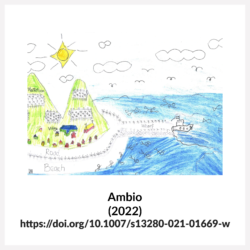
Publication Scientifique
Fache, E., Pauwels, S. The ridge-to-reef approach on Cicia Island, Fiji. Ambio (2022). https://doi.org/10.1007/s13280-021-01669-w
ABSTRACT
Many Pacific countries and territories embrace an officially recognized ‘ridge-to-reef’ approach to environmental management. This is the case of Fiji, where the Lau Seascape Strategy 2018–2030, led by Conservation International, aims for integrated natural resource management across 335 895 km2. This area includes Cicia Island, which deserves particular attention since, years before the design of the Lau Seascape Strategy, its population developed its own informal ridge-to-reef scheme, involving a combination of certified organic agriculture and locally managed marine closures... lire la suite
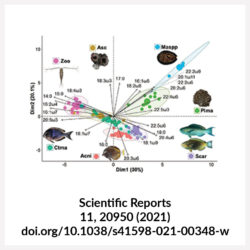
Publication Scientifique
Fey, P., Parravicini, V., Bănaru, D. et al. (2021). Multi-trophic markers illuminate the understanding of the functioning of a remote, low coral cover Marquesan coral reef food web. Scientific Reports, 11, 20950 (2021). 10.1007/s00227-021-03957-1.
ABSTRACT
We studied the food web structure and functioning of a coral reef ecosystem in the Marquesas Islands, French Polynesia, characterized by low coral cover, high sea surface temperature and meso- to eutrophic waters. The Marquesas constitute a relevant ecosystem to understand the functioning of low diversity reefs that are also subject to global change. A multi-tracer assessment of organic matter pathways was run to delineate ecosystem functioning, using analysis of fatty acids, bulk and compound specific stable isotope analysis and stable isotopes mixing models... lire la suite
Publication Scientifique
Zapata-Hernández, Germán & Hinojosa, Ivan & Sellanes, Javier & Rios, Rodrigo. (2021). The Diel changes in structure and trophic functions of motile benthic invertebrates on coral reefs at Rapa Nui (Easter Island) . Marine Biology, 168 (10), 154. 10.1007/s00227-021-03957-1.
ABSTRACT
Coral reefs are structurally complex habitats that provide diverse shelter for motile benthic invertebrates (MBI), including those with cryptic and nocturnal behaviors. In this study, diel changes in MBI structure (species composition, density, and biomass) and functions (trophic groups and isotopic diversity indices) were examined on coral reefs at Rapa Nui (27° S, 109° W). Diurnal and nocturnal surveys (March 2016) revealed that echinoderms were the dominant invertebrates throughout the diel cycle in terms of density, biomass, and their trophic role. ... lire la suite
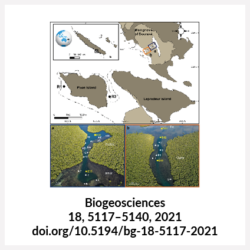
Publication Scientifique
Federica Maggioni, Mireille Pujo-Pay, Jérome Aucan, Carlo Cerrano, Barbara Calcinai, et al. (2021). The Bouraké semi-enclosed lagoon (New Caledonia) - a natural laboratory to study the lifelong adaptation of a coral reef ecosystem to extreme environmental conditions. Biogeosciences European Geosciences Union, 2021, (18), pp.5117-5140 .
ABSTRACT
According to current experimental evidence, coral reefs could disappear within the century if CO2 emissions remain unabated. However, recent discoveries of diverse and high cover reefs that already live under extreme conditions suggest that some corals might thrive well under hot, high-pCO2, and deoxygenated seawater. Volcanic CO2 vents, semi-enclosed lagoons, and mangrove estuaries are unique study sites where one or more ecologically relevant parameters for life in the oceans are close to or even worse than currently projected for the year 2100... lire la suite
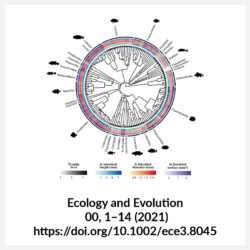
Publication Scientifique
Ghilardi, M., Schiettekatte, N., Casey, J., Brandl, S., Degregori, S., & Mercière, A., Morat, F., Bejarano, S., & Parravicini, V. (2021). Phylogeny, body morphology, and trophic level shape intestinal traits in coral reef fishes. Ecology and Evolution. 10.1002/ece3.8045.
ABSTRACT
- Trait-based approaches are increasingly used to study species assemblages and understand ecosystem functioning. The strength of these approaches lies in the appropriate choice of functional traits that relate to the functions of interest. However, trait–function relationships are often supported by weak empirical evidence.
- Processes related to digestion and nutrient assimilation are particularly challenging to integrate into trait-based approaches. In fishes, intestinal length is commonly used to describe these functions. Although there is broad consensus concerning the relationship between fish intestinal length and diet, evolutionary and environmental forces have shaped a diversity of intestinal morphologies that is not captured by length alone... lire la suite
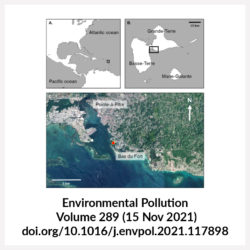
Publication Scientifique
CF. Bertucci, D. Lecchini, C. Greeven, R.M. Brooker, L. Minier, S. Cordonnier, M. René-Trouillefou, E. Parmentier (2021). Changes to an urban marina soundscape associated with COVID-19 lockdown in Guadeloupe. Environmental Pollution, 289: 117898. https://doi.org/10.1016/j.envpol.2021.117898
ABSTRACT
In 2020, the COVID-19 pandemic led to government-enforced limits on activities worldwide, causing a marked reduction of human presence in outdoors environments, including in coastal areas that normally support substantial levels of boat traffic. These restrictions provided a unique opportunity to quantify the degree to which anthropogenic noise contributes to and impacts underwater soundscapes. In Guadeloupe, French West Indies, a significantly lower number of motor boats were recorded in the vicinity of the major urban marina during the peak of the first COVID-19 lockdown (April–May 2020), compared with the number recorded post-lockdown. The resumption of human activities at the end of May was correlated with a maximum increase of 6 decibels in the ambient noise level underwater. ... lire la suite
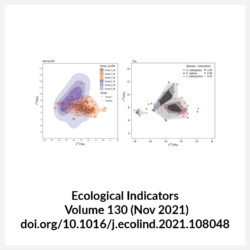
Publication Scientifique
Pauline Fey, Yves Letourneur, Silvère Bonnabel (2021). The α-minimum convex polygon as a relevant tool for isotopic niche statistics, Ecological Indicators, Volume 130, 2021, 108048, https://doi.org/10.1016/j.ecolind.2021.108048.
ABSTRACT
Ecological (isotopic) niche refers to a surface in a two-dimensional space, where the axes correspond to environmental variables that reflect values of stable isotopes incorporated in an animal's tissues. Carbon and nitrogen stable isotope ratios (δ13C-δ15N) notably provide precious information about trophic ecology, resource and habitat use, and population dynamics. Various metrics allow for isotopic niche size and overlap assessment. In this paper, we advocate α-minimum convex polygons (MCP) - that have long been used for home range estimation – as a relevant tool for isotopic niche size, overlap, and characteristics ... lire la suite
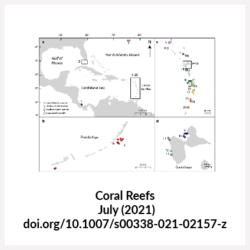
Publication Scientifique
Riquet, F., Japaud, A., Nunes, F.L.D. et al. Complex spatial patterns of genetic differentiation in the Caribbean mustard hill coral Porites astreoides. Coral Reefs (2021). https://doi.org/10.1007/s00338-021-02157-z
ABSTRACT
In contrast to most Caribbean corals, the mustard hill coral Porites astreoides Lamarck, 1816 has seen its relative coverage increasing across its distribution range in recent years. Interpreting the reasons of such success remains, however, challenging. On the one hand, genetic homogeneity has been observed over large distances, in line with a large effective population size and/or high migration rate. On the other hand, strong genetic differentiation has been recently observed across depths within regions, consistent with some of the life history traits of P. astreoides, such as brooding of larvae followed by a short larval pelagic duration. Based on seven informative microsatellite markers and extensive sampling covering a large part of the P. astreoides distribution in the Caribbean, including six depth transects, we assessed multi-scale genetic connectivity patterns to test whether populations were structured by bathymetry, microenvironments or geography. ... lire la suite
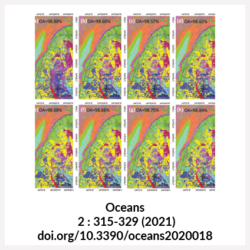
Publication Scientifique
Collin, A.; Andel, M.; Lecchini, D.; Claudet, J. Mapping Sub-Metre 3D Land-Sea Coral Reefscapes Using Superspectral WorldView-3 Satellite Stereoimagery. Oceans 2021, 2, 315-329. https://doi.org/10.3390/oceans2020018
ABSTRACT
Shallow coral reefs ensure a wide portfolio of ecosystem services, from fish provisioning to tourism, that support more than 500 million people worldwide. The protection and sustainable management of these pivotal ecosystems require fine-scale but large-extent mapping of their 3D composition. The sub-metre spaceborne imagery can neatly produce such an expected product using multispectral stereo-imagery. ... lire la suite
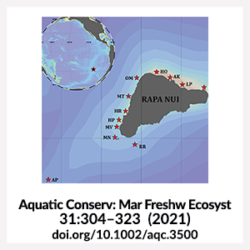
Publication Scientifique
Zapata‐Hernández, G., Sellanes, J., Letourneur, Y., et al. (2021). Tracing trophic pathways through the marine ecosystem of Rapa Nui (Easter Island).Aquatic Conserv: Mar Freshw Ecosyst, 31:304–323. https://doi.org/10.1002/aqc.3500
ABSTRACT
The structure of food webs provides important insight into biodiversity, organic matter (OM) pathways, and ecosystem functioning. Stable isotope analysis (δ13C and δ15N) was used to characterize the trophic structure and the main OM pathways supporting food webs in the Rapa Nui coastal marine ecosystem... lire la suite
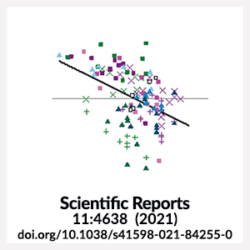
Publication Scientifique
Riekenberg, P.M., Briand, M.J., Moléana, T. et al. Isotopic discrimination in helminths infecting coral reef fishes depends on parasite group, habitat within host, and host stable isotope value. Sci Rep 11, 4638 (2021). https://doi.org/10.1038/s41598-021-84255-0.
ABSTRACT
Stable isotopes of carbon and nitrogen characterize trophic relationships in predator–prey relationships, with clear differences between consumer and diet (discrimination factor Δ13C and Δ15N). However, parasite–host isotopic relationships remain unclear, with Δ13C and Δ15N remaining incompletely characterized, especially for helminths. In this study, we used stable isotopes to determine discrimination factors for 13 parasite–host pairings of helminths in coral reef fish. Differences in Δ15N values grouped according to parasite groups and habitat within the host with positive Δ15N values observed for trematodes and nematodes from the digestive tract and variable Δ15N values observed for cestodes and nematodes from the general cavity.. .... lire la suite
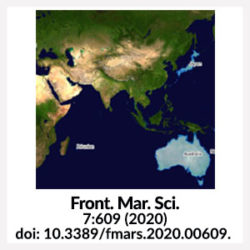
Publication Scientifique
O. Selmoni, G.Lecellier, L. Ainley, A. Collin, R. Doucet, V. Dubousquet, H. Feremaito, E. I. Waia, S. Kininmonth, H. Magalon, S. Malimali, A. Maugateau, A. Meibom, S. Mosese, M René-Trouillefou, N. Satoh, M. JH van Oppen, A. Xozamé, M. Yékawene, S. Joost and V. Berteaux-Lecellier. (2020) Using modern conservation tools for innovative management of coral reefs: the MANACO Consortium. Front. Mar. Sci., 7:609 doi: 10.3389/fmars.2020.00609.
ABSTRACT
Coral reefs are under threat and innovative management strategies are urgently required. However, discoveries from innovative fields of coral reef research are rarely transposed in practical conservation actions. This is mainly due to the difficulties in knowledge exchange between scientists and conservation stakeholders. The ManaCo consortium (http://manaco.ird.nc/) is an international network federating conservation stakeholders and researchers in a common effort to preserve the coral reefs. .... lire la suite
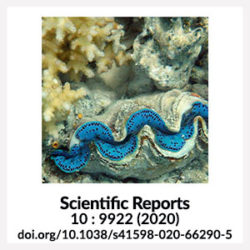
Publication Scientifique
Guibert I, Bourdreux F, Bonnard I, Pochon X, Dubousquet V, Raharivelomanana P, Berteaux-Lecellier V, Lecellier G. Dimethylsulfoniopropionate concentration in coral reef invertebrates varies according to species assemblages. Sci. Rep. 10 : 9922 (2020). https://doi.org/10.1038/s41598-020-66290-5
ABSTRACT
Dimethylsulfoniopropionate (DMSP) is a key compound in the marine sulfur cycle, and is produced in large quantities in coral reefs. In addition to Symbiodiniaceae, corals and associated bacteria have recently been shown to play a role in DMSP metabolism. Numerous ecological studies have focused on DMSP concentrations in corals, which led to the hypothesis that increases in DMSP levels might be a general response to stress. Here we used multiple species assemblages of three common Indo-Pacific holobionts, the scleractinian corals Pocillopora damicornis and Acropora cytherea, and the giant clam Tridacna maxima and examined the DMSP concentrations associated with each species within different assemblages and thermal conditions.... lire la suite
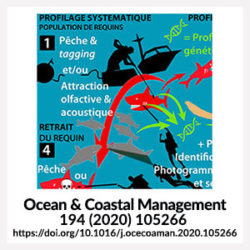
Publication Scientifique
Clua E.E.G, Linnell J.D.C., Planes S. and C.G. Meyer (2020). Selective removal of problem individuals as an environmentally responsible approach for managing shark bites on humans. Journal of Ocean and Coastal Management. 194 (2020) 105266. https://doi.org/10.1016/j.ocecoaman.2020.105266
ABSTRACT
Selective removal of problem individuals following shark bite incidents would be consistent with current management practices for terrestrial predators, and would be more effective and more environmentally responsible than current mass-culling programs. In parallel, and in addition to traditional forensics analysis, we recommend the routine collection of shark DNA from wounds or devices following shark bite incidents in order to genetically identify the individual responsible. This approach would require creating an extensive database of shark identities in high-risk areas against which to compare DNA forensically recovered from shark bite incidents.... lire la suite
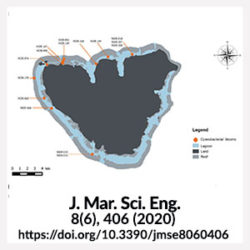
Publication Scientifique
Bonnard, I.; Bornancin, L.; Dalle, K.; Chinain, M.; Zubia, M.; Banaigs, B.; Roué, M. Assessment of the Chemical Diversity and Potential Toxicity of Benthic Cyanobacterial Blooms in the Lagoon of Moorea Island (French Polynesia). J. Mar. Sci. Eng. 2020, 8, 406. https://doi.org/10.3390/jmse8060406
ABSTRACT
In the last decades, an apparent increase in the frequency of benthic cyanobacterial blooms has occurred in coral reefs and tropical lagoons, possibly in part because of global change and anthropogenic activities. In the frame of the survey of marine benthic cyanobacteria proliferating in the lagoon of Moorea Island (French Polynesia), 15 blooms were collected, mainly involving three species—Anabaena sp.1, Lyngbya majuscula and Hydrocoleum majus-B..... lire la suite
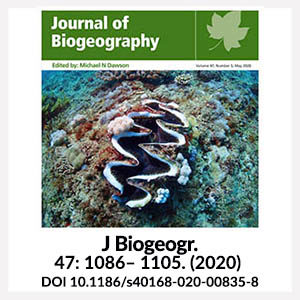
Publication Scientifique
Fauvelot, C, Zuccon, D, Borsa, P, et al. Phylogeographical patterns and a cryptic species provide new insights into Western Indian Ocean giant clams phylogenetic relationships and colonization history. J Biogeogr. 2020; 47: 1086– 1105. https://doi.org/10.1111/jbi.13797
ABSTRACT
The unique biodiversity in the Red Sea is the result of complex ecological and evolutionary processes driven by Pleistocene climatic change. Here we investigate the species diversity, phylogenetic relationships and phylogeographical patterns of giant clams in the Western Indian Ocean (WIO) and the Red Sea to explore scenarios of marine speciation in this under‐studied region.... lire la suite
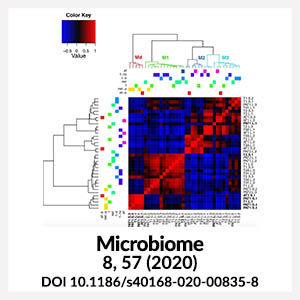
Publication Scientifique
Guibert, I., Lecellier, G., Torda, G. et al. Metabarcoding reveals distinct microbiotypes in the giant clam Tridacna maxima. Microbiome 8, 57 (2020). https://doi.org/10.1186/s40168-020-00835-8
ABSTRACT
Giant clams and scleractinian (reef-building) corals are keystone species of coral reef ecosystems. The basis of their ecological success is a complex and fine-tuned symbiotic relationship with microbes. While the effect of environmental change on the composition of the coral microbiome has been heavily studied, we know very little about the composition and sensitivity of the microbiome associated with clams. .... lire la suite
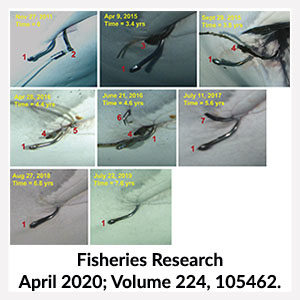
Publication Scientifique
Bègue, M., Clua, E., Siu, G., & Meyer, C. (2020). Prevalence, persistence and impacts of residual fishing hooks on tiger sharks. Fisheries Research, 224, 105462.
ABSTRACT
We used long-term observations of 55 individually identified tiger sharks (Galeocerdo cuvier) at a shark ecotourism site off Tahiti to estimate the prevalence, retention times and impacts of residual hooks and trailing line resulting from fisheries interactions. Thirty-eight percent of tiger sharks had at least one fisheries interaction resulting in retained hooks during the 8-year observation period. Both stainless-steel and corrodible hooks had a retention half-life of less than 1 year, and all corrodible hooks were shed within 2.5 years whereas firmly embedded stainless-steel hooks persisted for at least 7.6 years and are potentially retained for the lifetime of the shark.... lire la suite
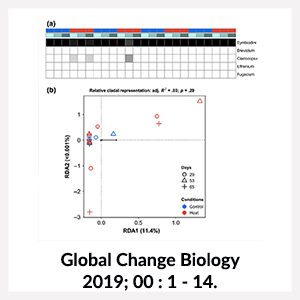
Publication Scientifique
Alves Monteiro, HJ, Brahmi, C, Mayfield, AB, Vidal‐Dupiol, J, Lapeyre, B, Le Luyer, J. Molecular mechanisms of acclimation to long‐term elevated temperature exposure in marine symbioses. Glob Change Biol, 2019; 00:1-14. https://doi.org/10.1111/gcb.14907
ABSTRACT
Seawater temperature rise in French Polynesia has repeatedly resulted in the bleaching of corals and giant clams. Because giant clams possess distinctive ectosymbiotic features, they represent a unique and powerful model for comparing molecular pathways involved in (a) maintenance of symbiosis and (b) acquisition of thermotolerance among coral reef organisms. Herein, we explored the physiological and transcriptomic responses of the clam hosts and their photosynthetically active symbionts over a 65 day experiment in which clams were exposed to either normal or environmentally relevant elevated seawater temperatures... lire la suite
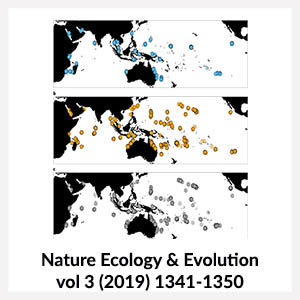
Publication Scientifique
Darling, E.S., McClanahan, T.R., Maina, J. et al. Social–environmental drivers inform strategic management of coral reefs in the Anthropocene. Nat Ecol Evol 3, 1341–1350 (2019) https://doi.org/10.1038/s41559-019-0953-8
ABSTRACT
Without drastic efforts to reduce carbon emissions and mitigate globalized stressors, tropical coral reefs are in jeopardy. Strategic conservation and management requires identification of the environmental and socioeconomic factors driving the persistence of scleractinian coral assemblages—the foundation species of coral reef ecosystems. Here, we compiled coral abundance data from 2,584 Indo-Pacific reefs to evaluate the influence of 21 climate, social and environmental drivers on the ecology of reef coral assemblages.... lire la suite
Publication Scientifique
Fey, P., Bustamante, P., Bosserelle, P., Espiaud, B., Malau, A., Mercader, M., Wafo, E. and Y. Letourneur (2019) Does trophic level drive organic and metallic contamination in coral reef organisms? Sci Total Environ, (667)208-221. https://doi.org/10.1016/j.scitotenv.2019.02.311
ABSTRACT
Metallic and organic pollutants constitute a serious threat for coral reef ecosystems, potentially affecting a great number of species interacting within complex trophodynamic processes. Pesticides, PCBs and trace elements were measured on coral reef communities of three Pacific islands (Moorea, Wallis and New Caledonia) in relation with δ15N values, a proxy of trophic level. Several potential sources of organic matter, benthic invertebrates and fish belonging to various trophic strategies were sampled at each island. .... lire la suite

